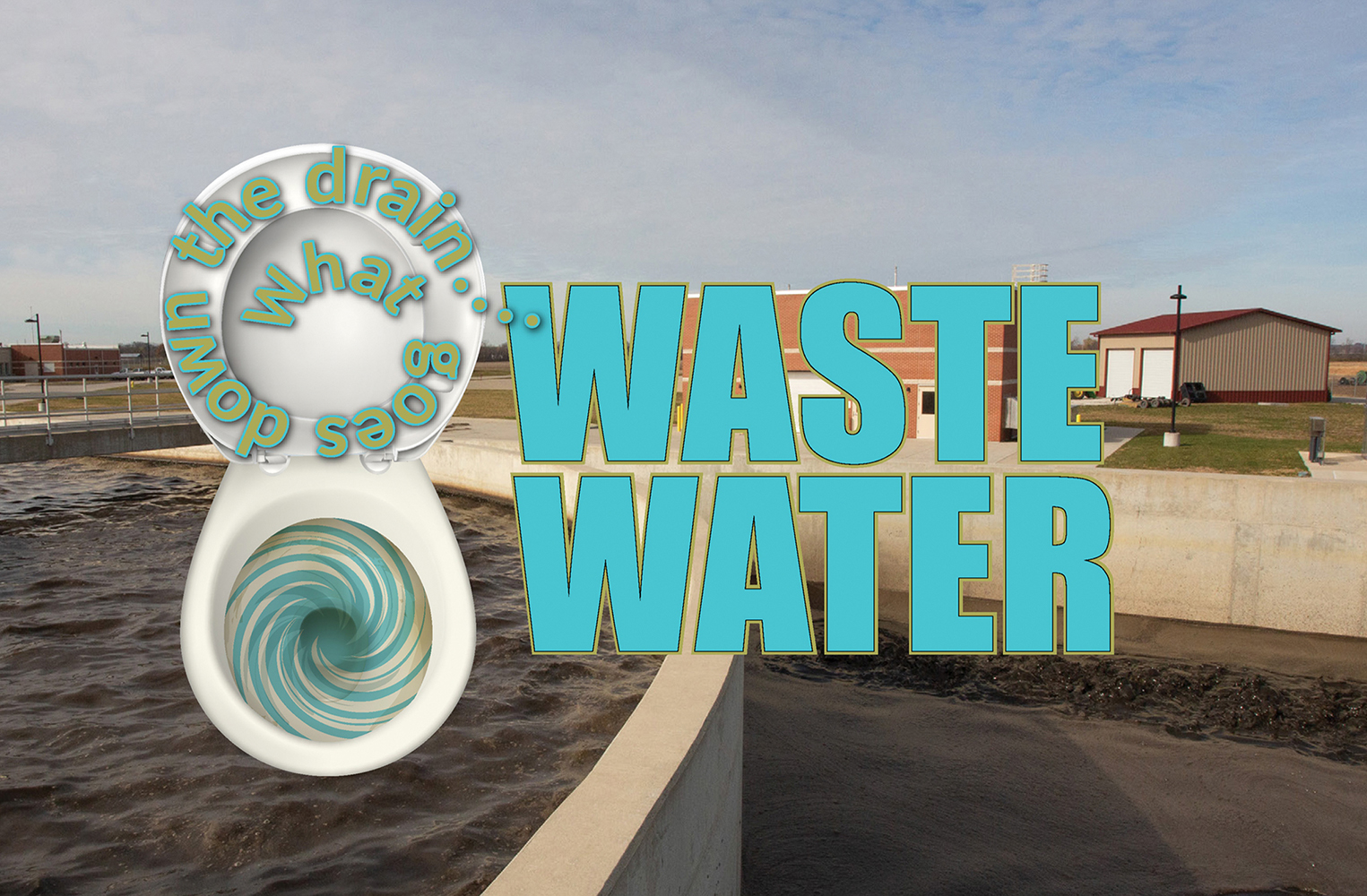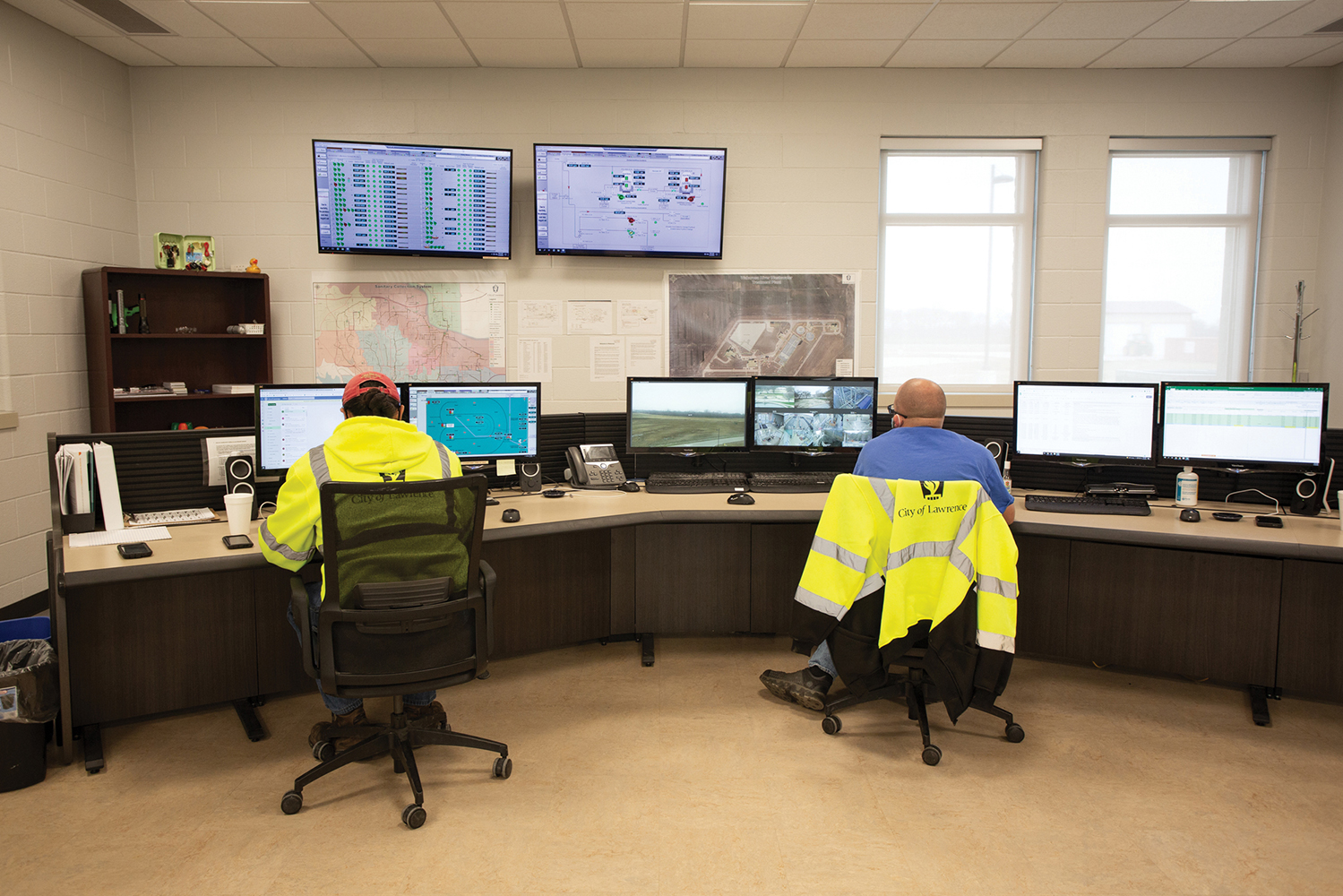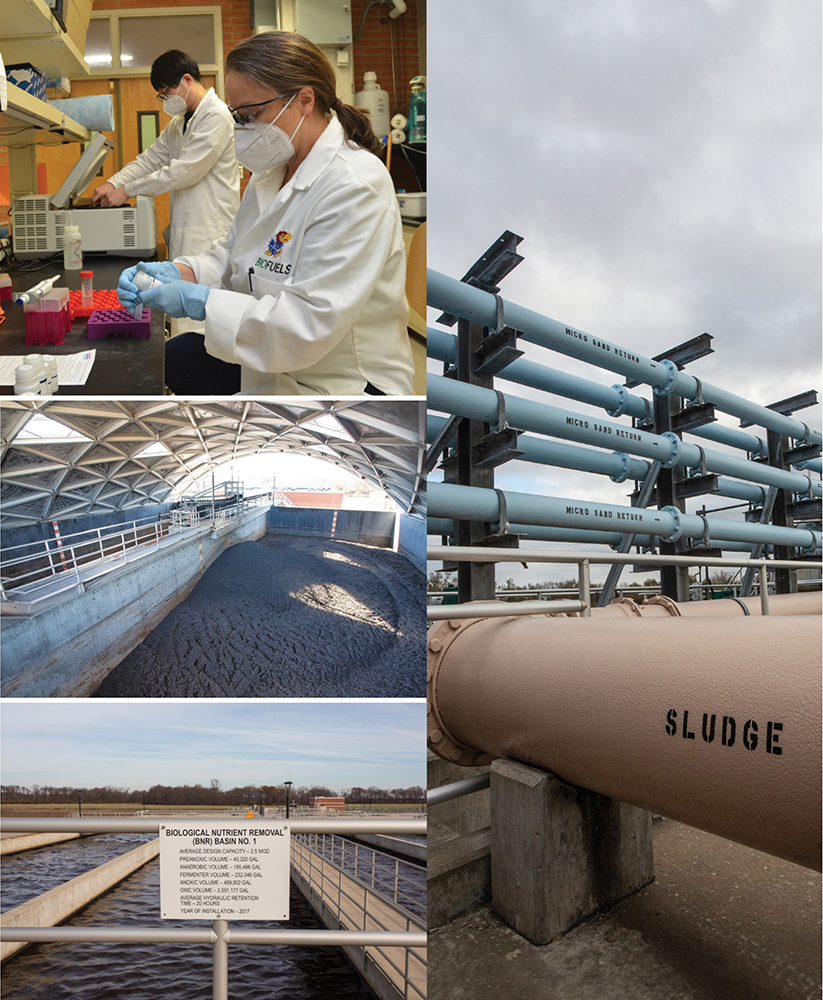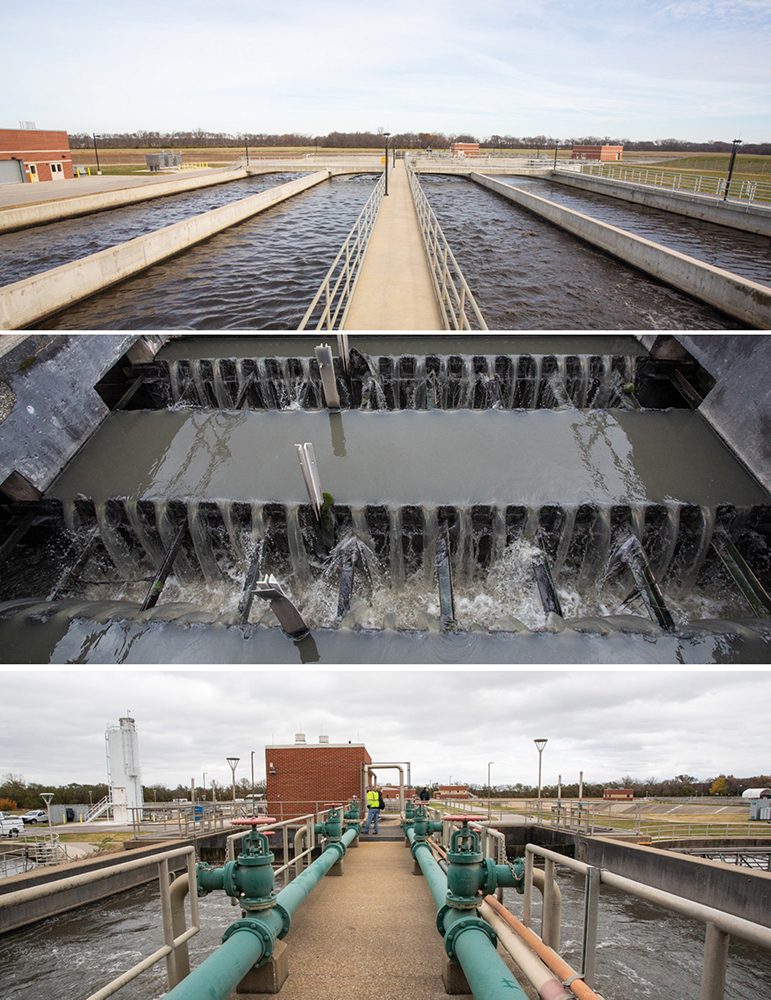| story by | |
| photos by | Steven Hertzog |
| OPEN A PDF OF THE ARTICLE |
Wastewater management is key to maintaining the health and well-being of community members and the environment.

Wakarusa Wastewater Treatment Plant
Wastewater may be the water system you don’t want to talk about, but wastewater is no joke. With America’s propensity for running water and flushable toilets, wastewater is a key infrastructure priority for cities and municipalities large and small, as well as for the individual homeowner outside the system using a septic tank. Wastewater departments are tasked with safely moving, treating and disposing of whatever goes down the drain or toilet.
Jay Lovett, manager for Wastewater Treatment Services for the City of Lawrence, manages two water-treatment plants, 35 sewer pump stations and four stormwater stations, and is also responsible for the personnel needed to run the facilities.
“The first thing that I’m responsible for is the crew of people that operate these plants. I have about 14 staff that operate these facilities 24/7, and I manage their efforts,” Lovett says. “I [also]oversee the treatment processes. These plants are designed to treat wastewater in a very specific way, and that process has to be supervised.”

The control room inside the Kaw River Water Treatment Plant
The wastewater treatment process is an involved and somewhat fascinating process with several steps to getting the water to a level it can be returned to the environment and the solids to fertilizer grade or sent to a landfill. These include filtering the wastewater and separating liquids and solids into two separate trains or treatment channels. The water train consists of several settling basins to remove more and more solids that are sent to the solids treatment, removing nutrients that cause harm downstream to wildlife, and then disinfecting and cleaning the water before it is returned to the environment. The solids that are gathered throughout the process are eventually separated into those that can be used for fertilizer and materials that must be sent to a landfill.
“The way I see it is that we allow gravity to take as many of the settled solids out of the sewer water as we can. We remove the trash, and we let gravity take care of as many of the organics that will settle,” Lovett explains. “We select for a biological mass that will get rid of the other bit of nutrients and things that we need. … That biology is different in each of our facilities, and it changes throughout the year. Basically, we grow pets.”
What Lovett fondly calls “pets” is the bacteria that is commonly referred to as “bugs” in the wastewater treatment process. This process uses organic material “bugs” to eat or digest the waste. These bugs are used to get rid of nutrients that can cause harm to the environment. The water and solids channels are constantly monitored and regulated to maintain the system, sustain the level of good bugs and keep the channels flowing, constantly adjusting to a fluctuating input volume that can change with the season and weather.

Jay Lovett stands above the wastewater at the 8th St Wastewater Plant (below) Assistant Director Trevor Flynn speaks to an informational tour group at the Kaw River Water Treatment Plant
Septic Systems
The septic process is slightly different from what goes on at the treatment facilities. Most houses outside of Lawrence use septic tanks, which are tanks that have lines into the ground that slowly seep water and, occasionally, have to be cleaned and emptied of solids by a septic tank cleaning company. Lovett, for his part, says it’s unlikely that any house outside of city limits will ever be connected to city sewer lines, even if they are close to the city limits, because of the limits on infrastructure.
“Sewer water has some characteristics that are pretty rough on infrastructure. Sewer water has to flow at a certain rate or becomes corrosive, it starts to create gasses, and it will chew up sewer lines,” he says. “So if you had a line that went from a mile out into the country all the way into town from everyone’s house, and it all just joined up that way, the lines would not last very long, and it would crumble to bits. Outside of city limits, you’re gonna have a septic tank. Connecting to city sewer is something that has to be close enough so that not only can you physically put the water there, but that it’s not going to decompose and cause problems with the infrastructure.”

Left – top to bottom:Students at KU test water samples for COVID. photo courtesy of Belinda Sturm Part of the solid composting process at the 8th St Wastewater Plant The BNR basin at the Wakarusa Wastewater Treatment Facility; Right: Series of pipes at the at the 8th St. Wastewater Plant
Dealing with Growth
With new technologies, it is a constant struggle to keep facilities upgraded, much less the cost of doing so. With population growth, however, Lovett says the technology needs to be installed, but it is not easy to do.
“Expanding treatment plants is a challenge,” he explains. “Some of the challenges are related to just the scope of a project. The technologies employed [at one plant]are 20 years old, and in that amount of time, things have changed enough that not only do we need new technology, we also need new support equipment for that technology. All of the infrastructure in the facility is old enough that it frequently has to be brought up to code before you can even put in the new technology to upgrade the facility for the water-quality goals that you have.”
Lovett says the number of challenges for an upgrade like that is high, and water that is coming in while the facility is under construction also has to be dealt with.
That expansion includes the Wakarusa River Wastewater Treatment Plant (WRWWTP), which opened in 2018, and a current $55-million plan to update the Kansas River Wastewater Treatment Plant (KRWWTP). Trevor Flynn, assistant director of Municipal Services and Operations, says the main reason these updates are taking place are to remain in compliance with state law.
“The current KRWWTP [Kansas River Wastewater Treatment Plant] National Pollutant Discharge Elimination System (NPDES) permit includes new nitrogen and phosphorus removal requirements. Wastewater treatment process enhancements are required to meet regulatory permit limits to reduce nutrients,” Flynn says. “In order to meet the new permit limits, a significant upgrade is necessary to alter our current treatment processes to improve our effluent water quality to the Kansas River.”
The upgrade project also includes an in-depth assessment of the plant, including improvement on process equipment, process piping, electrical service requirements, buildings, basins and the effluent outfall, he adds.
Testing
Just treating water and making sure it’s safe enough to go back out into the river is not all that the wastewater facility does. Josh Toevs, the water quality lab manager, runs the laboratory space inside the Kansas River Wastewater Treatment Plant. Toevs says the lab space is something that creates a lot of good for further developing treatment processes.
“Each plant has a lab. We actually have dedicated lab space, and it’s oversized on purpose to be able to collaborate with projects at [the University of Kansas]or [from]another researcher so that we have space to optimize our processes,” Toevs says. “Everything that we can do better saves [Lawrence payers] money. Our new plant came online in 2018, so it [has]state-of-the-art technology. It’s not just one of the best performing plants in Kansas, it’s one of the best performing plants in the Midwest.”
Belinda Sturm, associate vice chancellor for research and a professor in the Civil, Environmental and Architectural Engineering department at the University of Kansas (KU) is well-known for her research with wastewater, starting with an experiment creating biofuel out of algae grown from wastewater. This project, Sturm says, has made significant progress both academically and commercially since its start in 2007.
“Research never really ends, it just takes different phases. That project has morphed into another project. I have a Department of Energy project based off of … Version 5 of that project,” Sturm says. “Since we’ve been doing that research, there are full-scale companies selling algal wastewater treatment systems, and so this technology is being implemented at full scale. … We have not figured out, as a society, who figures out who does both [treatment and fuel-making]at once.”
There’s another layer of research to her current Department of Energy grant, she explains. Thermochemical conversion, taking biomass and putting it in a high-pressure cooker, is being adopted at full scale.

Wastewater Infrastructure at the Wakarusa Wastewater Treatment Facility (top), and at the 8th Street Wastewater Treatment Facility (middle and bottom)
COVID-19
“Lawrence is the only city that has been doing COVID wastewater testing weekly since June of 2020, and we will continue to do that with KU,” KRWWTP’s Toevs says.
And these days in the community, Sturm is known for testing wastewater for COVID-19 concentrations to determine the current levels of COVID-19 infection not just in our community but in several communities across Kansas.
“The director of the [Kansas] Bureau of Water called me in March of 2020 and asked me if I could measure the genes in the wastewater, because he had read a news story out of Europe where they were doing it,” Sturm says. “He gave me a few thousand dollars to buy the supplies that are needed to do it, and unfortunately, it was present in all of the wastewater we sampled. So that got us going. My first reaction was, ‘If they can do it, I can do it, so let’s try and see.’”
Her testing specifically involves extracting the waste of randomly chosen places inside communities and testing for the concentration of the virus in the waste. She says her research shows that it is possible to get a general idea of what is happening in a community through this method, which was incredibly useful early on in the pandemic.
“In general, it is surveillance of the prevalence of COVID in the community. Instead of taking samples from individuals and testing all the individuals, depending on where you take your sample of the wastewater collection system, if you’re testing a manhole, all of those folks attached to those toilets are being sampled for COVID at that moment,” Sturm explains. “We have been doing the wastewater influence for the whole community of Lawrence.”
Early on, when testing was not available, it was a way to get a snapshot of whether COVID was moving from communities, she says. Some of the first communities her team looked at were small, and everyone was surprised at the prevalence of COVID in the those towns then.
Research is an ongoing process, and Sturm’s is no exemption. It is still unclear what impact that vaccine is having on her research, Sturm adds, but early signs are good.
“It’s hard to tweeze out just the impact of vaccination, but we did have an early indication of that in Johnson County, because we were measuring in conjunction with Johnson County Wastewater two manholes just outside of long-term care facilities,” she explains. “We were measuring them before the vaccine came and after, and all those concentrations went to NORM detect. That was when, for me personally, I was very excited to get the vaccine.”
Concentrations have been going down during the last four months, Sturm adds, so it’s hard to say whether that’s vaccination or because we have seen Delta spikes. It’s harder to tell whether a COVID strain is the original or Delta variant with the current technology because it has to be sent off for sequencing to be determined.
The research she is doing has implications beyond just COVID: It could possibly be used for several other infectious diseases. She says she has already started testing the technology she is using to detect COVID in other places with other diseases, as well.
“KDHE [Kansas Department of Health and Environment] is funding this work, and the CDC [Centers for Disease Control and Prevention] has started just within the pandemic what is called the National Wastewater Surveillance System. In the most general terms, what I would say is that we are able to detect disease and specifically infectious disease … through wastewater,” Sturm explains. “I am working with a military base, and for the military, I think it’s very clear that this might be a way for them to really think about national security and infectious disease spread without having to sample all individuals on a base. This is a less-invasive way to get the health of a community without having to go to a human subject.”
Wastewater can tell us a lot about a community, and the environmental impacts of wastewater are limitless. Wastewater might be one thing no one wants to look at (or smell), but it is incredibly useful, not just to scientists but to the general population of any community, big or small. p
![]()




